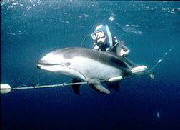EUROPEAN CETACEAN BYCATCH CAMPAIGN
"Man is but a strand in the complex web of life"
"Man is but a strand in the complex web of life"
Drift nets:
lacerations on the head, body, fins and tail fluke
caused by the net; bite marks on all parts of the body caused
by scavengers such as sharks; severed flukes, fins, and tails caused by fishermen using fire axes to remove the cetaceans from the nets: internal injuries and signs of asphyxiation.
Trawl nets and gear:
deep wounds to the head and body; severed beaks, fins, and tails caused by fishermen using fire axes to remove the cetaceans from the nets, sometimes whilst still alive; severe internal injuries including crushed organs; puncture wounds made by fishermen so that the body will sink and a quite recent development, beheading the animal, sometimes whilst still alive, when it has become stuck in the intake of a fish pump and blocked it.
If an ordinary individual carried out these acts of barbarism, the legislative procedure would ensure that the individual was punished. However, the fishing industry appears to be above the law.
The problem of cetacean bycatch is not a hopeless one. There are measures that can be taken to significantly reduce the number of needless deaths.
Efforts to address bycatch problems in other countries, e.g. USA and New Zealand, are underpinned by targeted legislation and a legal framework of wide ranging duties and powers, including the power of enforcement.
In the USA, under the Marine Mammal Protection Act (Amended 1994), the immediate goal was that the incidental mortality or serious injury of marine mammals in commercial fishing operations, should be reduced to insignificant levels approaching zero by 30 April 2001.
There has been an assessment of marine mammal stocks; there is a marine mammal mortality monitoring programme for commercial fisheries, whereby, observers monitor the degree of bycatch and then Take Reduction Teams, which develop strategies to reduce cetacean bycatch, formulate Take Reduction Plans, which are discussed with scientists, environmentalists, animal welfare groups, fishery managers and fishermen. The plans are then put into action.
In 1994, it was estimated that 2100 harbour porpoises were killed in the Gulf of Maine gillnet fisheries each year. In January 1999, a TRP was put into effect. The deaths of harbour porpoises were reduced to 270.
In the Mid-Atlantic gillnet fishery, it was estimated that an average of 358 harbour porpoises were killed in nets each year (1995 - 1998). After the introduction of a TRP in 1999, the estimated bycatch for that year was 49 harbour porpoises.
Take Reduction Plans, incorporate measures such as, observer monitoring, area closures, reduction in the size of the fishery, pingers on nets and modification to fishing gear and practice. Enforcement measures and penalties, that are sufficiently costly, are used to ensure that fishermen comply with regulations designed to reduce cetacean bycatch.
In the autumn of this year a new type of gillnet is being trialled in the USA. It is called an" acoustically reflective gillnet". Trials of this net took place in the Bay of Fundy, Canada, in 1998 and 2000. The results were so promising that the Scientific Committee of the International Whaling Commission, endorsed further experimentation with these nets and the Gulf of Maine Take Reduction Team recommended that a large scale trial be conducted this year.
In contrast, very little is being done by the Member States of the European Community to reduce the level of cetacean bycatch. Each country blames the others for the problem. Each Minister for Fisheries blames the others and "encourages" their own fishermen to take measures to reduce bycatch.
However, the USA and New Zealand have enforcement measures and the United Nations Environment Programme's Annual Report 1999, states that "The foundation of any successful international, regional, or national initiative on environmental protection, is consensus backed up by law.....there is need for.....detecting and prosecuting violators".
The EU Commission has initiated further research into the problem, even though there have been in excess of twenty EU funded reports in the last ten years all showing need for action.
Principle 15 of the Rio Earth Summit states that "In order to protect the Environment, the precautionary approach shall be adopted by States. Where there are threats of serious damage, lack of full scientific certainty shall not be used as reason for postponing measures to prevent environment degradation".
There is no explicit legal provision in European law to deal with the problem of cetacean Bycatch.
Article 6 of the Amsterdam Treaty provides for the legal framework of fisheries policy to be amended to incorporate measures to address environmental concerns.
Therefore, the European Common Fisheries Policy could be amended to incorporate cetacean bycatch mitigation measures, with explicit provision in European law.
It is now time for the citizens of the European Community to demand these changes, in order to reduce the number of cetaceans dying needlessly, every year, in European waters
MPs, MEPs, animal welfare organisations, environmental groups, and ordinary individuals are lobbying the Commissioner for Fisheries, Franz Fischler, and the Commissioner for the Environment, Margot Wallstrom, to take action on this issue.
We ask you to write to your MP, your MEP, and the two Commissioners.
We also ask you to write to supermarkets and fish suppliers asking whether that they obtain their fish from fleets with a low rate of cetacean bycatch.
Franz Fischler
European Commissioner for Agriculture and Fisheries
200, Rue de la Loi
B - 1049
Brussels
Belgium
European Commissioner for Agriculture and Fisheries
200, Rue de la Loi
B -
Brussels
Belgium
Margot Wallstrom
Commissioner for the Environment
200, Rue de la Loi
B - 1049
Brussels
Commissioner for the Environment
200, Rue de la Loi
B -
Brussels
Please speak out on behalf of these beautiful, gentle and intelligent creatures, who cannot speak out for themselves.
Alan & Mary Stuart
Letters should now be addressed to
Letters should now be addressed to
Mr. Joe Borg
European Commissioner for Fisheries and Maritime Affairs,
200, Rue de la Loi,
B-1049,
Brussels
Mr. Stavros Dimas
European Commissioner for the Environment
200, Rue de la Loi
B -
Brussels
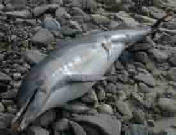
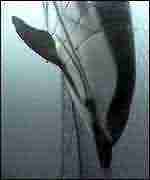
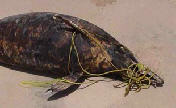
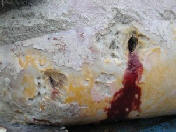

Porpoises frequently use echo location to find their prey.
If acoustically reflective gill nets (containing a barium sulphate filler) are deployed, it has been shown that porpoises and sea-birds are less likely to become entangled.
